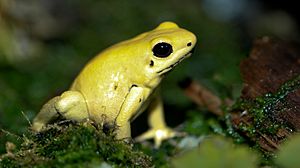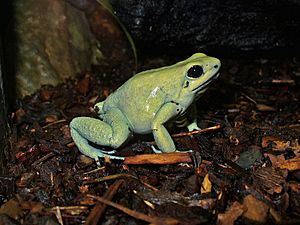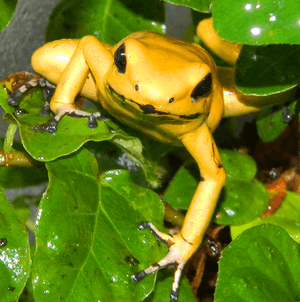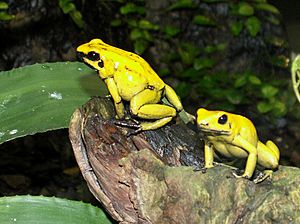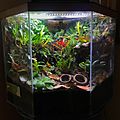Golden poison frog facts for kids
The golden poison frog (Phyllobates terribilis) is a type of poison dart frog. It lives only on the Pacific coast of Colombia. It's also known as the golden frog or golden dart frog.
Quick facts for kids Phyllobates terribilis |
|
|---|---|
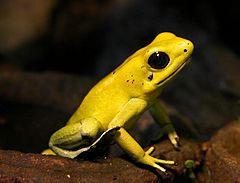 |
|
| Scientific classification | |
| Kingdom: | |
| Class: | |
| Order: | |
| Suborder: | |
| Family: | |
| Genus: |
Phyllobates
|
| Binomial name | |
| Phyllobates terribilis |
|
Contents
Amazing Poison of the Golden Frog
The skin of the golden poison frog is covered in a very strong alkaloid poison. This poison is called batrachotoxin. It stops nerves from sending signals. This makes muscles stay tight, which can lead to heart failure.
It's important to know that this frog is poisonous, not venomous. Venomous animals, like snakes, have a way to inject their poison, such as fangs. Poisonous animals, like this frog, don't inject it. Their poison works if you touch or eat them. The golden poison frog uses its poison only to protect itself, not to hunt.
A wild golden poison frog usually has about one milligram of poison. This is enough to kill about 10,000 mice. It's also enough to kill 10 to 20 humans. This poison is one of the most deadly natural poisons known.
Like most poisonous frogs, the golden poison frog keeps its poison in special glands in its skin. Because of this poison, predators usually avoid eating them. Most animals that try to eat a golden poison frog will die. However, one type of snake, Liophis epinephelus, is somewhat resistant to the poison.
Interestingly, the frogs themselves are immune to their own poison. Also, golden poison frogs raised in captivity usually don't produce poison. This is because they don't eat the specific insects in the wild that give them the chemicals needed to make the poison.
What Does the Golden Poison Frog Look Like?
The golden poison frog is the largest type of poison dart frog. Adults can grow up to 55 mm (about 2.2 inches) long. Females are usually bigger than males. Like all poison dart frogs, they have bright colors. These bright colors are a warning sign to predators that the frog is poisonous. This is called aposematic coloration.
The frog has tiny sticky pads on its toes. These help it climb plants. It also has a special bone plate in its lower jaw. This makes it look like it has teeth, which is unusual for frogs. The golden poison frog is usually active during the day.
There are three main color types, or morphs, of the golden poison frog:
Mint Green Morph
This is the largest type of golden poison frog. It lives in the La Brea area of Colombia. These frogs can be metallic green, light green, or even white. The name "mint green" can be a bit confusing because of the variety of colors.
Yellow Morph
The yellow morph is why this frog is often called the "golden poison dart frog." These frogs are found in Quebrada Guangui, Colombia. They can be light yellow to a deep, golden yellow.
Orange Morph
Orange golden poison frogs are not as common as the other two types. They are found in Colombia and can be metallic orange or yellow-orange. Their color can vary in how bright it is.
What Do Golden Poison Frogs Eat?
In the wild, golden poison frogs mainly eat ants from the Brachymyrmex and Paratrechina groups. They also eat many other small invertebrates, like termites and beetles, which they find on the rainforest floor. These frogs are known for eating a lot!
When kept as pets, they eat fruit flies, cochineals, crickets, and other small live insects. Adult frogs can eat much larger food items compared to their size than most other poison dart frogs. Baby frogs (tadpoles) eat algae, mosquito larvae, and other tiny things in their water nursery.
Golden Frogs and Indigenous People
The golden poison frog is very important to the local native groups, like the Emberá people in Colombia's rainforest. This frog is the main source of the poison they use on their hunting darts.
The Emberá people carefully hold the frog over a fire. The heat makes the frog release small amounts of its poisonous fluid. They then dip the tips of their arrows and darts into this fluid. The darts stay deadly for more than two years!
How Golden Poison Frogs Behave
Golden poison frogs are thought to be one of the smartest types of frogs. If they are kept as pets, they can even recognize the people who care for them after just a few weeks. They are also very good at catching food with their long, sticky tongues. They almost never miss! This shows they have good eyesight and brainpower.
Golden poison frogs are curious and brave. They seem to know that they are almost impossible to harm. They don't try to hide and even show off their bright colors to scare away animals that might want to eat them.
These frogs are social animals. In the wild, they usually live in groups of four to seven frogs. When kept as pets, they can live in groups of 10 or even 15. They rarely fight with other frogs of their own kind. Since they are immune to their own poison, they can interact with each other all the time. They communicate by making calls and by using body language. For example, doing "push-up" movements can show that a frog is dominant, while lowering their head seems to show they are giving in.
Life Cycle and Reproduction
Golden poison frogs are very caring parents. They lay their eggs on the ground, usually hidden under fallen leaves. Once the tadpoles hatch from their eggs, they stick to the mucus on the backs of their parents.
The adult frogs then carry their tiny young up into the trees. They place each tadpole into small pools of water that collect in plants called bromeliads or in holes in trees. The tadpoles grow there, eating algae and mosquito larvae. After they change into froglets (small frogs), the parents lead them to join an existing group of frogs.
Images for kids
See also
 In Spanish: Rana de dardo venenosa para niños
In Spanish: Rana de dardo venenosa para niños


